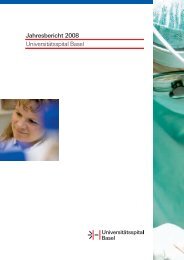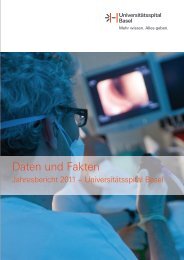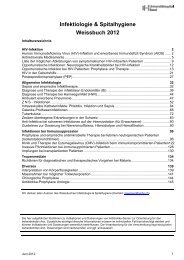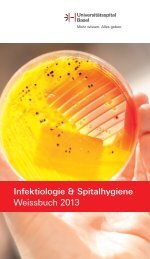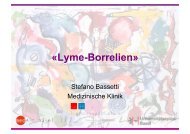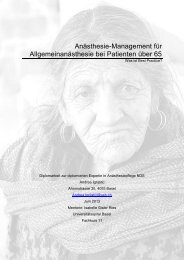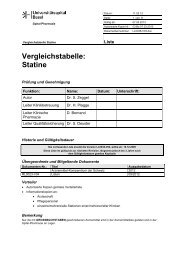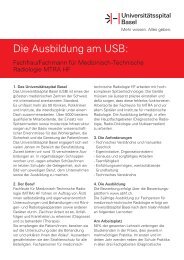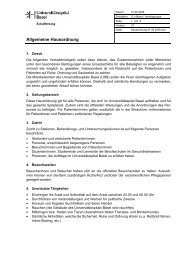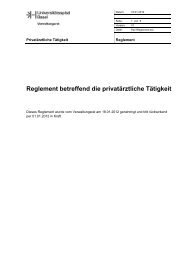Transmucosal Nasal Drug Delivery: Systemic Bioavailability of ...
Transmucosal Nasal Drug Delivery: Systemic Bioavailability of ...
Transmucosal Nasal Drug Delivery: Systemic Bioavailability of ...
Create successful ePaper yourself
Turn your PDF publications into a flip-book with our unique Google optimized e-Paper software.
4. Compounding <strong>of</strong> nasal midazolam preparations<br />
4.4.2 Applications <strong>of</strong> chitosan<br />
Chitosan is a multifunctional excipient with a wide rang <strong>of</strong> industrial applications (e.g., flocculant for<br />
wastewater clarification, chelating <strong>of</strong> heavy metals, clarification <strong>of</strong> fruit juices and beers, and<br />
fungicide in agriculture) [Shahidi and Abuzaytoun 2005]. Further, in food industry, chitosan is a<br />
popular dietary supplement, particularly in Japan. In addition, chitosan is used for ophthalmic<br />
applications, such as contact lens coating or as the contact lenses material itself and in cosmetic<br />
industry chitosan is also a very popular excipient (e.g., for hair care products).<br />
Chitosan is a versatile excipient for miscellaneous pharmaceutical applications. Chitosan is<br />
adjuvant in direct compressed tablets, for controlled release matrix tablets, in the process <strong>of</strong> wet<br />
granulation, in gels, films, and emulsions, as well as wetting and coating agent, and for the<br />
production <strong>of</strong> microspheres and microcapsules. Chitosan is used also in newer research areas like<br />
nasal vaccine delivery and DNA delivery [van der Lubben et al., 2001; Xu et al., 2004]. The<br />
European Pharmacopoeia describes the requirements for chitosan hydrochloride used in<br />
pharmaceutical products.<br />
4.4.3 Chitosan in transmucosal nasal drug delivery<br />
Davis et al. were the first to demonstrate the cationic polymer chitosan to promote the<br />
transmucosal adsorption <strong>of</strong> challenging drugs, particularly with regard to improved nasal delivery.<br />
In animal and human models, chitosan generated a remarkably higher bioavailability [Davis and<br />
Illum 2003]. Illum et al found, that the addition <strong>of</strong> chitosan to a nasal formulation <strong>of</strong> insulin caused<br />
plasma glucose to fall to 43% <strong>of</strong> basal level compared to 83% without the addition <strong>of</strong> chitosan [Illum<br />
et al., 1994]. Similar effects on bioavailability have been achieved for polar low-molecular-weight<br />
drugs (e.g., morphine and antimigraine drugs). Chitosan is an effective nasal absorption enhancer<br />
in liquid and powder formulations. Chitosan improve bioavailability in nasal and pulmonal drug<br />
delivery [Illum 1998; Illum et al., 2002; Martinac et al., 2005; Yu et al., 2004].<br />
In liquid formulations for nasal drug delivery, concentrations <strong>of</strong> 0.5-1.0% chitosan proved to<br />
promote absorption [Davis and Illum 2003].<br />
Unlike common penetration enhancers, chitosan is neither membrane active nor a classical<br />
surfactant and is not transmucosal absorbed. The clearance <strong>of</strong> chitosan formulations from the<br />
nasal cavity <strong>of</strong> sheep and humans has been shown to be significantly slower compared with<br />
aqueous solutions [Soane et al., 1999; Soane et al., 2001].<br />
The mucoadhesion results <strong>of</strong> the interaction between the linear cationic polysaccharide chitosan<br />
and the negatively charged mucosa. This mechanism decelerates the nasal clearance [Aspden et<br />
al., 1997].<br />
The extended time <strong>of</strong> contact <strong>of</strong> the formulation and the nasal mucosa favors the transmucosal<br />
drug absorption [Pavis et al., 2002]. Studies with CaCo-2 cell monolayer suggest cationic polymers<br />
(e.g., chitosan) to modify permeability <strong>of</strong> the monolayer by interaction with the gating mechanism <strong>of</strong><br />
tight junction, causing a transient opening [Artursson et al., 1994]. Dodane et al. demonstrated<br />
Katja Suter-Zimmermann Page 40 <strong>of</strong> 186 University <strong>of</strong> Basel, 2008




